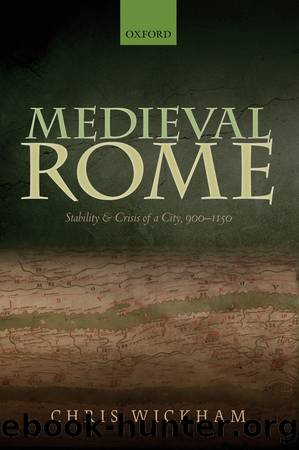Medieval Rome by Wickham Chris;

Author:Wickham, Chris; [Wickham, Chris]
Language: eng
Format: epub
Publisher: Oxford University Press, Incorporated
Published: 2014-08-28T00:00:00+00:00
5
Medium Elites and Church Clienteles
The Society of Romeâs Regions in the Eleventh and Twelfth Centuries
We saw in Chapter 3 that Romeâs small and bustling regiones were quite different from each other in their economic focus and in their overall prosperity.1 How this worked at the level of social relationships is much harder to pin down. As usual, in the period before notarial archives begin, we only have restricted sets of data: a large number of urban leases and sales of leases; smaller sets of documents recording gifts to the church, and credit arrangements with pledges in land; and a few wills and dowry agreements, which sometimes have the advantage of listing all or most of the landed possessions of the author of the text. Rome also has rather less documentation than some more favoured cities, as we have seen. But we can use this material, all the same, and it is possible to say something about the different societies of at least some of the regiones of the city, those which are illuminated by the largest documentary sets we have. These are three in number: Trastevere (as seen through the eyes of the monastery of SS. Cosma e Damiano in Trastevere), Pigna (as seen from the monastery of SS. Ciriaco e Nicolaâhere, as before, S. Ciriacoâin Via Lata), and S. Maria Nova/Colosseo (as seen from the diaconia of S. Maria Nova). The local documentation for each hardly begins before 1000; in addition, it increases substantially in most areas after 1150. I shall therefore also use late twelfth-century material here to add to our understanding of how each regio changed; this chapter thus discusses the eleventh and twelfth centuries as a whole. Much of our reconstruction has to remain hypothetical, even in the best-documented case, S. Maria Nova, for the evidence has too many gaps. All the same, we shall find that the society of each of these three was indeed different, and this partly matches their economic contrasts. This chapter includes plenty of detailed workings-out of examples, because only by doing that can we get a sense of those differences. As in Chapter 4, that detail may fascinate some, but may alienate others. My defence, nonetheless, is that it seems to me necessary, if we want to get a sense of local societies with any accuracy at all.
The people who will stand in the foreground of this chapter are the broad stratum which I have already defined as the âmedium eliteâ. This is because the data we have, as just described, tell us far more about that stratum than they do about any less prosperous and prominent social groups. A normal rural study (outside Romeâs own hinterland, that is) can often say quite a lot about the rural poor, because they at least worked the land, and land is the basic focus of surviving documents for most of the Middle Ages. Inside cities, this is rather harder, because the urban poor do not appear in any detail in our sources,
Download
This site does not store any files on its server. We only index and link to content provided by other sites. Please contact the content providers to delete copyright contents if any and email us, we'll remove relevant links or contents immediately.
The Daily Stoic by Holiday Ryan & Hanselman Stephen(2708)
The Fate of Rome: Climate, Disease, and the End of an Empire (The Princeton History of the Ancient World) by Kyle Harper(2436)
People of the Earth: An Introduction to World Prehistory by Dr. Brian Fagan & Nadia Durrani(2346)
Ancient Worlds by Michael Scott(2103)
Babylon's Ark by Lawrence Anthony(2070)
Foreign Devils on the Silk Road: The Search for the Lost Treasures of Central Asia by Peter Hopkirk(2056)
India's Ancient Past by R.S. Sharma(1987)
MOSES THE EGYPTIAN by Jan Assmann(1972)
The Complete Dead Sea Scrolls in English (7th Edition) (Penguin Classics) by Geza Vermes(1840)
Lost Technologies of Ancient Egypt by Christopher Dunn(1797)
The Daily Stoic by Ryan Holiday & Stephen Hanselman(1768)
The Earth Chronicles Handbook by Zecharia Sitchin(1744)
24 Hours in Ancient Rome by Philip Matyszak(1678)
Alexander the Great by Philip Freeman(1648)
Aztec by Gary Jennings(1545)
The Nine Waves of Creation by Carl Johan Calleman(1520)
Curse Tablets and Binding Spells from the Ancient World by Gager John G.;(1510)
Before Atlantis by Frank Joseph(1483)
Earthmare: The Lost Book of Wars by Cergat(1467)
